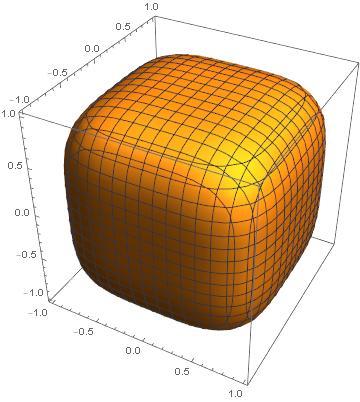Interesting Limit (26)
Let L n denote the arc length of the curve x 2 n + y 2 n = 1 , where n is a positive integer. Find n → ∞ lim L n .
The answer is 8.
This section requires Javascript.
You are seeing this because something didn't load right. We suggest you, (a) try
refreshing the page, (b) enabling javascript if it is disabled on your browser and,
finally, (c)
loading the
non-javascript version of this page
. We're sorry about the hassle.
7 solutions
See What is the limit volume of this figure as n goes to infinity?
"This is not a requirement to solve this problem. If you like, then determining this limit will give you a major clue:
Assuming [ ∣ x ∣ ≤ 1 , n → ∞ lim x → 1 lim x 2 n ] "

lim n → ∞ x 2 n = ⎩ ⎪ ⎨ ⎪ ⎧ 0 1 ∞ for ∣ x ∣ < 1 for ∣ x ∣ = 1 for ∣ x ∣ > 1
The only way to make the equation true at n → ∞ is for one of { ∣ x ∣ , ∣ y ∣ } to be 1 and the other to be less than 1. The locus of points thus described is a square of perimeter 8 .
By inspection, in the limit:
1)
Neither
x
nor
y
can have a magnitude greater than
1
2)
x
and
y
cannot both have a magnitude less than
1
3)
The only permissible combination is one variable at exactly
1
, with the other variable having a magnitude of less than
1
4)
This results in a square, centered on the origin, with a side length of
2
and a perimeter of
8
It therefore appears that a square is related to a circle in a somewhat unexpected way, with both curves being limiting cases of a more general curve. The square is the "high n " limit and the circle is the "low n " limit
How about the curve length of ∣ x ∣ n m + ∣ y ∣ n m = 1 where m , n are positive integers and n → ∞ ?
As n gets larger and larger, the contours of x^(2n) + y^(2n) = 1 approach that of a SQUARE with a side length of 2, centered at (0,0)
When y is from interval (-1,1) the y^(2n) as n goes to infinity goes to zero, because even if it is 0,999999999 it must go to zero. So as y is from that interval x is either 1 or -1 and when y is either 1 or -1 x is from interval (-1,1) so when we imagine, how will the graph looks like, we will notice that it is a square with side lenght 2, so the answer is the perimeter of this square, which is 2*4=8.
For x ∈ ( − 1 , 1 ) , n → ∞ lim x 2 n = 0 ⟹ y = ± 1 . Since the equation is symetrical, this also holds when we swap x and y .
The resulting curve is a square of perimeter 8 .